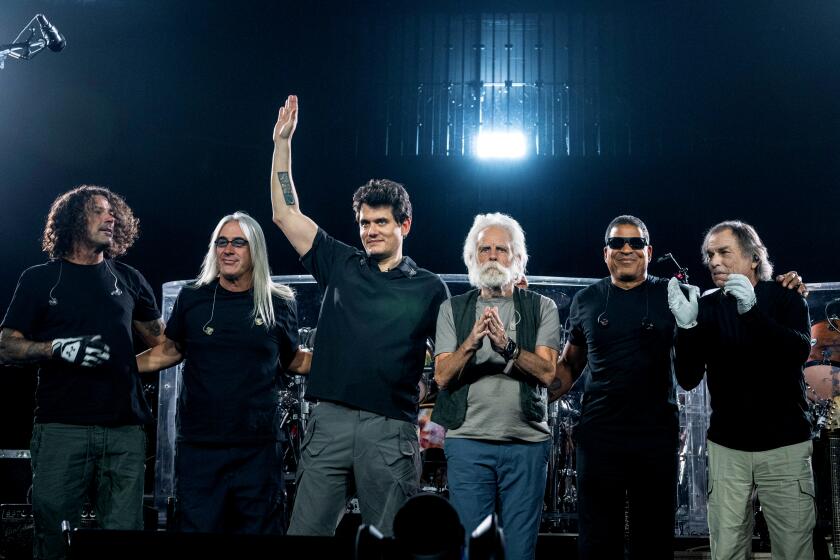Exclusive: Doors drummer John Densmore on ‘Chasing Trane’ and the price musicians pay chasing their art
John Densmore, founding member of the Doors, is among the numerous interview subjects in director John Scheinfeld’s new documentary “Chasing Trane,” tracking the life and career of influential jazz saxophonist John Coltrane.
Following a recent question-answer session Densmore took part in after a screening of the film at the Arclight in Hollywood, Densmore submitted this essay unsolicited to The Times addressing the price musicians pay for what they do day in and day out.
“Chasing Trane” is due for home video release on DVD and Blu-ray in September.
Former President Bill Clinton is very eloquent about saxophonist John Coltrane in the new documentary “Chasing Trane” because he’s been there. Not that the prez is the Prez (Lester Young’s nickname) … far from it, but Bill did learn how to operate a tenor saxophone.
You see, if you’re a layperson and haven’t picked up a musical instrument, or a tennis racket for that matter, you don’t physically understand what it takes to make that shot or play that riff. It takes a tremendous amount of time learning the craft. And in doing so … you pay. Physically, you pay … and pay … and pay.
See the most-read stories in Entertainment this hour »
Every job has an occupational hazard, whether you’re jackhammering on a roadway, or playing violin. Some part of your body (or several) has to “take” that constant over-and-over impact.
Sandy Koufax had several operations on that gifted, left-handed pitching arm. Ravi Shankar admitted that his spine was twisted into a knot from years of sitting in front of that sitar. Freddie Hubbard knocked many years off his life not pacing himself channeling air into that tiny trumpet mouthpiece.
Miles Davis, of course, paid. Look at his posture. While coaxing out that totally unique muted tone, his body was shaped like an “L.” Why? Cause that’s how he had to do it. Think about it: The mouthpiece of a trumpet is a tiny, little hole into which the player channels wind. Most folks don’t realize that playing trumpet is very hard on your entire body.
Yes, the lips pay, but notice how trumpet players usually have an exaggerated vein going up their forehead. It’s from trying to squeeze the exact amount of wind required to stay in tune, and also hit high notes.
Coltrane was one of the first tenor players to switch from the old, plastic, black mouthpieces that made Coleman Hawkins famous to the silver metal ones. The old plastic ones were bigger and usually produced a heavy vibrato sound, whereas the new metal ones were smaller and elicited a more narrow tone.
The space for air to come into the horn is smaller (like the trumpet), and the trap of metal mouthpieces is to produce a “cold” or modern sound. JC chose to use a No. 5 reed (the wooden piece under the mouthpiece that vibrates), to counteract that problem; No. 5s are very hard pieces of wood.
That forced John to dig deeper into his abdomen for more air, but it produced a warmer sound. Hard work, but he was reaching for something new. It turned into a simply gorgeous sound, full of empathy, passion and every emotion in the human condition — from the rage over four girls killed in the bombing of a church in a song called “Alabama,” to the gentle feeling of photosynthesis in “After the Rain.”
Coltrane is so in my blood. Every time I go outside after a storm, I “hear” that melody. Of course, it was the man behind the horn, fingering and blowing, which transformed that air into soul. the man who spent years and years in “the woodshed,” running those scales on his “ax.”
So Bill knows what he is talking about. He studied sax for many years in school, and seeing him play on Arsenio Hall certainly proved that he wasn’t the next John Coltrane, but he knows the fingering. He knows physically how much breath is needed to do the “sheets of sound” that Coltrane is famous for.
Therefore, his comments in director John Scheinfeld’s loving portrait of the most famous sax player to ever pick up a horn is “right on.”
OK, I must now admit that yours truly is in the film doc on Coltrane, so some of this might seem self-serving. Some of it is, but I just did three months of physical therapy for bulging discs in my neck from slumping over my drums for 50 years.
Musicians pay. As do road workers. I have ringing in my ears from rock ’n’ roll; construction guys have the same from nail guns.
You know what, though? It’s all worth it. If you have to contort muscles to produce whatever you’re working on, so be it. That’s why high-rise buildings should have a plaque outside on the wall listing all the workers who built those skyscrapers … all of them.
And hopefully readers of this will have a new understanding and respect for the toll musicians pay for the love of their craft.
Follow @RandyLewis2 on Twitter.com
For Classic Rock coverage, join us on Facebook
More to Read
The biggest entertainment stories
Get our big stories about Hollywood, film, television, music, arts, culture and more right in your inbox as soon as they publish.
You may occasionally receive promotional content from the Los Angeles Times.









